599 scholarly books by Russell Sage Foundation and 10
have author last names that start with J
599 scholarly books by Russell Sage Foundation and 10
599 scholarly books by Russell Sage Foundation
10 have author last names that start with J have author last names that start with J
10 have author last names that start with J have author last names that start with J
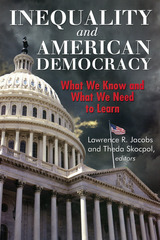
Inequality and American Democracy
What We Know and What We Need to Learn
Lawrence R. Jacobs
Russell Sage Foundation, 2005
In the twentieth century, the United States ended some of its most flagrant inequalities. The "rights revolution" ended statutory prohibitions against women's suffrage and opened the doors of voting booths to African Americans. Yet a more insidious form of inequality has emerged since the 1970s—economic inequality—which appears to have stalled and, in some arenas, reversed progress toward realizing American ideals of democracy. In Inequality and American Democracy, editors Lawrence Jacobs and Theda Skocpol headline a distinguished group of political scientists in assessing whether rising economic inequality now threatens hard-won victories in the long struggle to achieve political equality in the United States. Inequality and American Democracy addresses disparities at all levels of the political and policy-making process. Kay Lehman Scholzman, Benjamin Page, Sidney Verba, and Morris Fiorina demonstrate that political participation is highly unequal and strongly related to social class. They show that while economic inequality and the decreasing reliance on volunteers in political campaigns serve to diminish their voice, middle class and working Americans lag behind the rich even in protest activity, long considered the political weapon of the disadvantaged. Larry Bartels, Hugh Heclo, Rodney Hero, and Lawrence Jacobs marshal evidence that the U.S. political system may be disproportionately responsive to the opinions of wealthy constituents and business. They argue that the rapid growth of interest groups and the increasingly strict party-line voting in Congress imperils efforts at enacting policies that are responsive to the preferences of broad publics and to their interests in legislation that extends economic and social opportunity. Jacob Hacker, Suzanne Mettler, and Dianne Pinderhughes demonstrate the feedbacks of government policy on political participation and inequality. In short supply today are inclusive public policies like the G.I. Bill, Social Security legislation, the War on Poverty, and the Voting Rights Act of 1965 that changed the American political climate, mobilized interest groups, and altered the prospect for initiatives to stem inequality in the last fifty years. Inequality and American Democracy tackles the complex relationships between economic, social, and political inequality with authoritative insight, showcases a new generation of critical studies of American democracy, and highlights an issue of growing concern for the future of our democratic society.
[more]
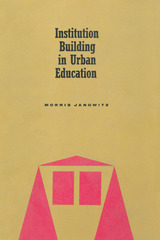
Institution Building in Urban Education
Morris Janowitz
Russell Sage Foundation, 1968
Presents a sociological perspective on the issues involved in transforming the structure of inner city schools. This book evaluates the models which have guided past and present attempts at educational reform, and proposes a coherent theory for attacking the problems of urban education. Dr. Janowitz examines the inner city school as a social system—the physical structure, community setting, people involved, and persistent patterns of behavior. He analyzes the current trend of specialization teaching and recommends instead an "aggregation" model which increases the scope of the individual teacher and restructures the climate of the school.
[more]
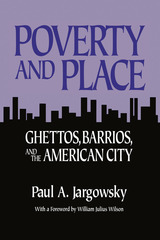
Poverty and Place
Ghettos, Barrios, and the American City
Paul A. Jargowsky
Russell Sage Foundation, 1997
"[An] alarming report, a rigorous study packed with charts, tables, 1990 census data and [Jargowsky's] own extensive field work.... His careful analysis of enterprise zones, job-creation strategies, local economic development schemes and housing and tax policies rounds out an essential handbook for policy makers, a major contribution to public debate over ways to reverse indigence." —Publishers Weekly "A data-rich description and a conceptually innovative explanation of the spread of neighborhood poverty in the United States between 1970 and 1990. Urban scholars and policymakers alike should find Jargowsky's compelling arguments thought-provoking. "—Library Journal "A powerful book that allows us to really understand how ghettos have been changing over time and the forces behind these changes. It should be required reading of anyone who cares about urban poverty." —David Ellwood, Malcolm Wiener Professor of Public Policy, John F. Kennedy School of Government, Harvard University Poverty and Place documents the geographic spread of the nation's ghettos and shows how economic shifts have had a particularly devastating impact on certain regions, particularly in the rust-belt states of the Midwest. Author Paul Jargowsky's thoughtful analysis of the causes of ghetto formation clarifies the importance of widespread urban trends, particularly those changes in the labor and housing markets that have fostered income inequality and segregated the rich from the poor. Jargowsky also examines the sources of employment that do exist for ghetto dwellers, and describes how education and family structure further limit their prospects. Poverty and Place shows how the spread of high poverty neighborhoods has particularly trapped members of poor minorities, who account for nearly four out of five ghetto residents. Poverty and Place sets forth the facts necessary to inform the public understanding of the growth of concentrated poverty, and confronts essential questions about how the spiral of urban decay in our nation's cities can be reversed.
[more]
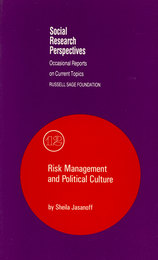
Risk Management and Political Culture
Sheila Jasanoff
Russell Sage Foundation, 1986
This unique comparative study looks at efforts to regulate carcinogenic chemicals in several Western democracies, including the United States, and finds marked national differences in how conflicting scientific interpretations and competing political interests are resolved. Whether risk issues are referred to expert committees without public debate or debated openly in a variety of forums, patterns of interaction among experts, policy makers, and the public reflect fundamental features of each country's political culture. "A provocative argument....Poses interesting questions for the sociology of science, especially science produced for public debate."—Contemporary Sociology A Volume in the Russell Sage Foundation's Social Science Frontiers Series
[more]
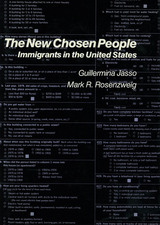
The New Chosen People
Immigrants in the United States
Guillermina Jasso
Russell Sage Foundation, 1990
Stories of immigrant success have traditionally illustrated the basic principles of political and economic freedom in the United States. In reality, the presence and achievements of the foreign-born are the complex result of attitudes, choices, and decisions, not only of the immigrants themselves but also of the U.S. government and its native-born citizens. Based on census data and government administrative records, The New Chosen People presents a comprehensive picture of this interaction as the authors examine immigrant behavior in the United States. Jasso and Rosenzweig trace the factors that influence the immigrants' adjustment and achievements in a broad area of concerns—learning English, finding work and earning a living, and raising a family. The authors devote special attention to family relationships—kinship migration, family reunification, and the marriage market—and to the factors determining where immigrants choose to settle. Jasso and Rosenzweig also consider the situation of the largest recent groups of refugees—Cubans and Indochinese—who have entered the U.S. under very different rules than those governing the selection of immigrants from other countries. They also look at how the foreign-born population has changed over time, drawing comparisons between post-1960 immigrants and those of 1900 through 1910. For all foreign-born, the authors discuss the factors that influence decisions to naturalize and the economic and social consequences of achieving legal status. Jasso and Rosenzweig also detail the policy choices that affect the composition of the foreign-born population. What criteria determine who is eligible to enter the country? How do these regulations differ for each country of origin, and how have they changed over the years? The New Chosen People emphasizes the determining influence of choice and selection on the foreign-born population of the United States. For policymakers and social scientists, the book provides a valuable assessment of the economic and social well-being of the nation and its newcomers. A Volume in the Russell Sage Foundation Census Series
[more]
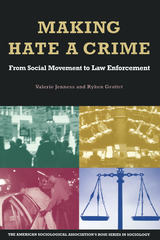
Making Hate A Crime
From Social Movement to Law Enforcement
Valerie Jenness
Russell Sage Foundation, 2001
Violence motivated by racism, anti-Semitism, misogyny, and homophobia weaves a tragic pattern throughout American history. Fueled by recent high-profile cases, hate crimes have achieved an unprecedented visibility. Only in the past twenty years, however, has this kind of violence—itself as old as humankind—been specifically categorized and labeled as hate crime. Making Hate a Crime is the first book to trace the emergence and development of hate crime as a concept, illustrating how it has become institutionalized as a social fact and analyzing its policy implications. In Making Hate a Crime Valerie Jenness and Ryken Grattet show how the concept of hate crime emerged and evolved over time, as it traversed the arenas of American politics, legislatures, courts, and law enforcement. In the process, violence against people of color, immigrants, Jews, gays and lesbians, women, and persons with disabilities has come to be understood as hate crime, while violence against other vulnerable victims-octogenarians, union members, the elderly, and police officers, for example-has not. The authors reveal the crucial role social movements played in the early formulation of hate crime policy, as well as the way state and federal politicians defined the content of hate crime statutes, how judges determined the constitutional validity of those statutes, and how law enforcement has begun to distinguish between hate crime and other crime. Hate crime took on different meanings as it moved from social movement concept to law enforcement practice. As a result, it not only acquired a deeper jurisprudential foundation but its scope of application has been restricted in some ways and broadened in others. Making Hate a Crime reveals how our current understanding of hate crime is a mix of political and legal interpretations at work in the American policymaking process. Jenness and Grattet provide an insightful examination of the birth of a new category in criminal justice: hate crime. Their findings have implications for emerging social problems such as school violence, television-induced violence, elder-abuse, as well as older ones like drunk driving, stalking, and sexual harassment. Making Hate a Crime presents a fresh perspective on how social problems and the policies devised in response develop over time. A Volume in the American Sociological Association's Rose Series in Sociology
[more]
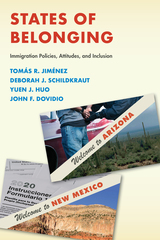
States of Belonging
Immigration Policies, Attitudes, and Inclusion
Tomas R. Jimenez
Russell Sage Foundation, 2021
Political turmoil surrounding immigration at the federal level and the inability of Congress to pass comprehensive immigration reform have provided an opening for state and local governments to become more active in setting their own immigration-related policies. States largely dictate the resources, institutions, and opportunities immigrants can access: who can get a driver’s license or attend a state university, what languages are spoken in schools and public offices, how law enforcement interacts with the public, and even what schools teach students about history. In States of Belonging, an interdisciplinary team of immigration experts – Tomás R. Jiménez, Deborah J. Schildkraut, Yuen J. Huo, and John F. Dovidio – explore the interconnections among immigration policies, attitudes about immigrants and immigration, and sense of belonging in two neighboring states – Arizona and New Mexico – with divergent approaches to welcoming newcomers.
Arizona and New Mexico are historically and demographically similar, but they differ in their immigration policies. Arizona has enacted unwelcoming policies towards immigrants, restricting the access of immigrants to state resources, social services, and public institutions. New Mexico is more welcoming, actively seeking to protect the rights of immigrants and extending access to state resources and institutions. The authors draw on an original survey and in-depth interviews of a cross-section of each state’s population to illustrate how these differing approaches affect the sense of belonging not only among immigrants, but among the U.S.-born as well.
Respondents in Arizona, regardless of whether they were foreign- or native-born or their ethno-racial background, agreed that the state is unwelcoming to immigrants, and they pointed to Arizona’s restrictive policies as the primary factor. The sense of rejection perceived by Latinos in Arizona, including the foreign-born and the U.S.-born, was profound. They felt the effects of administrative and symbolic exclusions of the state’s unwelcoming policies as they went about their daily lives.
New Mexico’s more welcoming approach had positive effects on the Latino immigrant population, and these policies contributed to an increased sense of belonging among U.S.-born Latinos and U.S.-born whites as well. The authors show that exposure to information about welcoming policies is associated with an improved sense of belonging across most population groups. They also find that the primary dividing line when it came to reactions to welcoming policies was political, not ethno-racial. Only self-identified Republicans, Latino as well as white, showed reduced feelings of belonging.
States of Belonging demonstrates that welcoming policies cultivate a greater sense of belonging for immigrants and other state citizens, suggesting that policies aimed at helping immigrants gain a social, economic, and political foothold in this country can pay a broad societal dividend.
Arizona and New Mexico are historically and demographically similar, but they differ in their immigration policies. Arizona has enacted unwelcoming policies towards immigrants, restricting the access of immigrants to state resources, social services, and public institutions. New Mexico is more welcoming, actively seeking to protect the rights of immigrants and extending access to state resources and institutions. The authors draw on an original survey and in-depth interviews of a cross-section of each state’s population to illustrate how these differing approaches affect the sense of belonging not only among immigrants, but among the U.S.-born as well.
Respondents in Arizona, regardless of whether they were foreign- or native-born or their ethno-racial background, agreed that the state is unwelcoming to immigrants, and they pointed to Arizona’s restrictive policies as the primary factor. The sense of rejection perceived by Latinos in Arizona, including the foreign-born and the U.S.-born, was profound. They felt the effects of administrative and symbolic exclusions of the state’s unwelcoming policies as they went about their daily lives.
New Mexico’s more welcoming approach had positive effects on the Latino immigrant population, and these policies contributed to an increased sense of belonging among U.S.-born Latinos and U.S.-born whites as well. The authors show that exposure to information about welcoming policies is associated with an improved sense of belonging across most population groups. They also find that the primary dividing line when it came to reactions to welcoming policies was political, not ethno-racial. Only self-identified Republicans, Latino as well as white, showed reduced feelings of belonging.
States of Belonging demonstrates that welcoming policies cultivate a greater sense of belonging for immigrants and other state citizens, suggesting that policies aimed at helping immigrants gain a social, economic, and political foothold in this country can pay a broad societal dividend.
[more]
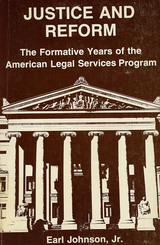
Justice and Reform
The Formative Years of the OEO Legal Services Program
Earl Johnson
Russell Sage Foundation, 1974
Justice and Reform is the first study of the origins, philosophy, creation, management, and impact of the Office of Economic Opportunity Legal Services Program. As such, it clearly and concisely describes the Program's role both as an instrument of equal justice and as a strategy for overcoming poverty. Timely, important, and unique, it tells the story behind the OEO Legal Services Program—an endeavor that has been called both the most successful element of the war on poverty and the most stimulating development to occur in the American legal profession during the Twentieth Century. The early chapters in the book reveal the nature and motivations of the two groups which joined to create the Program: the conservative, American Bar Association sponsored 89-year-old legal aid movement and the Ford Foundation-financed neighborhood lawyer experiments that started in 1962 under the direction of young activist lawyers. Why they merged and how they merged forms the background for a description of how the partners persuaded the OEO bureaucracy to start a legal services program and convinced over 200 communities (including most large cities) to set up a federally funded legal assistance agency. Legal Services Program established policy, how it settled upon "law reform" as the priority function of the Program, how it preserved the integrity of its policies within OEO, and how it caused its grantees to engage in law reform. Chapter 8 evaluates, for the first time, the economic, political, and social impact of the Program as of 1972. The final chapter speculates on the future of government-subsidized legal assistance in the United States from the perspective of the OEO program's twin goals of equal justice and social reform.
[more]
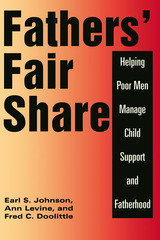
Fathers' Fair Share
Helping Poor Men Manage Child Support and Fatherhood
Earl S. Johnson
Russell Sage Foundation, 1999
One of the most challenging goals for welfare reformers has been improving the collection of child support payments from noncustodial parents, usually fathers. Often vilified as deadbeats who have dropped out of their children's lives, these fathers have been the target of largely punitive enforcement policies that give little consideration to the complex circumstances of these men's lives. Fathers' Fair Share presents an alternative to these measures with an in-depth study of the Parents Fair Share Program. A multi-state intervention run by the Manpower Demonstration Research Corporation, the program was designed to better the life skills of nonpaying fathers with children on public assistance, in the belief that this would encourage them to improve their level of child support. The men chosen for the program frequently lived on the margins of society. Chronically unemployed or underemployed, undereducated, and often earning their money on the streets, they bore the scars of drug or alcohol abuse, troubled family lives, and arrest records. Among those of African American and Hispanic descent, many felt a deep-rooted distrust of the mainstream economy. The Parents Fair Share Program offered these men the chance not only to learn the social skills needed for stable employment but to participate in discussions about personal difficulties, racism, and problems in their relationships with their children and families. Fathers' Fair Share details the program's mix of employment training services, peer support groups, and formal mediation of disputes between custodial and noncustodial parents. Equally important, the authors explore the effect of the participating fathers' expectations and doubts about the program, which were colored by their often negative views about the child support and family law system. The voices heard in Fathers' Fair Share provides a rare look into the lives of low-income fathers and how they think about their struggles and prospects, their experiences in the workplace, and their responsibilities toward their families. Parents Fair Share demonstrated that, in spite of their limited resources, these men are more likely to make stronger efforts to improve support payments and to become greater participants in their children's lives if they encounter a less adversarial and arbitrary enforcement system. Fathers' Fair Share offers a valuable resource to the design of social welfare programs seeking to reach out to this little-understood population, and addresses issues of tremendous importance for those concerned about welfare reform, child support enforcement, family law, and employment policy.
[more]
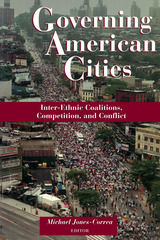
Governing American Cities
Inter-Ethnic Coalitions, Competition, and Conflict
Michael Jones-Correa
Russell Sage Foundation, 2001
The new immigrants who have poured into the United States over the past thirty years are rapidly changing the political landscape of American cities. Like their predecessors at the turn of the century, recent immigrants have settled overwhelmingly in a few large urban areas, where they receive their first sustained experience with government in this country, including its role in policing, housing, health care, education, and the job market. Governing American Cities brings together the best research from both established and rising scholars to examine the changing demographics of America's cities, the experience of these new immigrants, and their impact on urban politics. Building on the experiences of such large ports of entry as Los Angeles, New York, Miami, Houston, Chicago, and Washington D.C., Governing American Cities addresses important questions about the incorporation of the newest immigrants into American political life. Are the new arrivals joining existing political coalitions or forming new ones? Where competition exists among new and old ethnic and racial groups, what are its characteristics and how can it be harnessed to meet the needs of each group? How do the answers to these questions vary across cities and regions? In one chapter, Peter Kwong uses New York's Chinatown to demonstrate how divisions within immigrant communities can cripple efforts to mobilize immigrants politically. Sociologist Guillermo Grenier uses the relationship between blacks and Latinos in Cuban-American dominated Miami to examine the nature of competition in a city largely controlled by a single ethnic group. And Matthew McKeever takes the 1997 mayoral race in Houston as an example of the importance of inter-ethnic relations in forging a successful political consensus. Other contributors compare the response of cities with different institutional set-ups; some cities have turned to the private sector to help incorporate the new arrivals, while others rely on traditional political channels. Governing American Cities crosses geographic and disciplinary borders to provide an illuminating review of the complex political negotiations taking place between new immigrants and previous residents as cities adjust to the newest ethnic succession. A solution-oriented book, the authors use concrete case studies to help formulate suggestions and strategies, and to highlight the importance of reframing urban issues away from the zero-sum battles of the past.
[more]
READERS
Browse our collection.
PUBLISHERS
See BiblioVault's publisher services.
STUDENT SERVICES
Files for college accessibility offices.
UChicago Accessibility Resources
home | accessibility | search | about | contact us
BiblioVault ® 2001 - 2024
The University of Chicago Press









